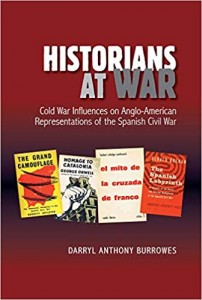Book Review: Cold War Influences on Anglo–American Hispanists
 Darryl Anthony Burrowes, Historians at War: Cold War Influences on Anglo–American Representations of the Spanish Civil War. Brighton, Great Britain: Sussex Academic Press, 2019.
Darryl Anthony Burrowes, Historians at War: Cold War Influences on Anglo–American Representations of the Spanish Civil War. Brighton, Great Britain: Sussex Academic Press, 2019.
As the Cold War came to dominate the postwar world, it appeared obvious that the United States and the United Kingdom needed Franco more than he needed them. This context inevitably shaped the British and American narratives of the Spanish Civil War. It is well known that western government agencies wanted to encourage a more positive portrayal of Francoist Spain while diminishing positive mentions of the role in the war of the Soviet Union, the Comintern, and the International Brigades.
Was Spanish Civil War historiography during the Cold War “prey to intelligence agency maneuverings behind the scene or was it immune from such manipulation?” This is the central question informing Darryl Burrowes’ Historians at War, published by Sussex in the Cañada Blanch series directed by Paul Preston. To answer it, Burrowes presents a close study of the lives and works of four men who had a major impact on the historiography of the Spanish Civil War and whose names everyone who reads English-language histories of the Spanish Civil War will recognize: George Orwell, Gerald Brenan, Burnett Bolloten, and Herbert Southworth. In his book, Burrowes examines possible links between intelligence agencies and Orwell, Brenan, and Bolloten. While the case of Southworth does not fit quite so neatly, his long-running dispute with Bolloten makes him an ideal comparison. (The book appears to be a published version of Burrowes’ 2017 doctoral dissertation, although the only mention of this thesis is in an endnote.)
Burrowes’ research took him to archives in England, the Netherlands, Scotland, Spain, and the United States, where, among other archives, he consulted the ALBA collection at NYU. He uses biography and “friendship networks” to “determine the writer-historian’s psychological profile and see how they could have been open to, and influenced by, ideas prevalent at the time.” The extent to which intelligence agencies may have assisted in the publication and dissemination of histories of the Spanish Civil War is well documented and Burrowes’ research on this point is a strength of this book. Still, his conclusions remain only suggestive. He cannot offer any conclusive evidence that his subjects softened or changed their work on the Civil War to gain favor with intelligence agencies.
A great deal of Burrowes’ work is based on drawing inferences from his sources. There is often no direct line between statements and conclusions. Burrowes makes a lot of suggestive and plausible links between the publication of works and Cold War politics but does not necessarily substantiate that the authors were “bought” by CIA gold. That they were influenced by their milieu and circles of acquaintances is a given; people flock to be with people who share similar views. However, just because people share views on one subject does not indicate a shared perspective or that these perspectives do not evolve. I am a tremendous soccer fan, so is Henry Kissinger—and there the similar views end (as far as I know). I am as proud of my work as a former board member of ALBA as my work with anarchist groups but certain anti-communist historians assert I am at best a fellow traveler—a fellow traveler who admires Bolloten’s work.
Burrowes provides a great deal of information on the lives of the four subjects and their personal relationships, which occasionally leads him to include harsh moral judgments. (For example, he speaks of Brenan’s “predatory sexual life and self-serving morality,” mostly due to his having fathered a child with a 15-year old maid and his bigamous marriage with Gamel Woolsey.) Not surprisingly, at times all four men appear to have been strapped for funds. For the sections of his work that deal with the CIA-sponsored Congress for Cultural Freedom, Burrowes relies almost exclusively on secondary sources, despite listing in his bibliography the American Committee for Cultural Freedom Records at NYU’s Tamiment Library. In addition to his archival research, Burrowes also contacted numerous living historians of the Spanish Civil War. All of them appear cited by name, except for one “reputable Spanish Civil War historian who wishes to remain anonymous.” The anonymous source was included, Burrowes writes, because of “[t]his scholar’s recollections…of the negative and unflattering critique offered of Southworth.” The scholar’s desire to remain anonymous means we are relying solely on Burrowes’ assessment of the validity of this individual’s work. To be able to place this criticism of Southworth in context I would have preferred to know who this source was.
This book is not for the faint–hearted. There are 1381 endnotes for the 182 pages. Unfortunately, my review reads like the Mueller Report leading to no clear conclusions. The best advice I can give readers is to read Paul Preston’s introduction and decide for themselves.
Andrew H. Lee is a curator at NYU and teaches courses in the History Department.












